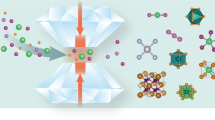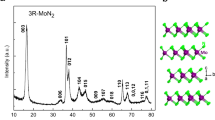Abstract
U60 ([UO2(O2)(OH)]6060− in water) is a uranyl peroxide nanocluster with a fullerene topology and Oh symmetry. U60 clusters can exist in crystalline solids or in liquids; however, little is known of their behavior at high pressures. We compressed the U60-bearing material: Li68K12(OH)20[UO2(O2)(OH)]60(H2O)310 (\(Fm\bar 3\); a = 37.884 Å) in a diamond anvil cell to determine its response to increasing pressure. Three length scales and corresponding structural features contribute to the compression response: uranyl peroxide bonds (<0.5 nm), isolated single nanoclusters (2.5 nm), and the long-range periodicity of nanoclusters within the solid (>3.7 nm). Li68K12(OH)20[UO2(O2)(OH)]60(H2O)310 transformed to a tetragonal structure below 2 GPa and irreversibly amorphized between 9.6 and 13 GPa. The bulk modulus of the tetragonal U60-bearing material was 25 ± 2 GPa. The pressure-induced amorphous phase contained intact U60 clusters, which were preserved beyond the loss of long-range periodicity. The persistence of U60 clusters at high pressure may have been enhanced by the interaction between U60 nanoclusters and the alcohol pressure medium. Once formed, U60 nanoclusters persist regardless of their associated long-range ordering—in crystals, amorphous solids, or solutions.








Similar content being viewed by others
References
G. Sigmon, J. Ling, D. Unruh, L. Moore-Shay, M. Ward, B. Weaver, and P. Burns: Uranyl–peroxide interactions favor nanocluster self-assembly. J. Am. Chem. Soc. 131, 16648 (2009).
P. Miró, S. Pierrefixe, M. Gicquel, A. Gil, and C. Bo: On the origin of the cation templated self-assembly of uranyl-peroxide nanoclusters. J. Am. Chem. Soc. 132, 17787 (2010).
B. Vlaisavljevich, L. Gagliardi, and P. Burns: Understanding the structure and formation of uranyl peroxide nanoclusters by quantum chemical calculations. J. Am. Chem. Soc. 132, 14503 (2010).
P. Burns and K. Hughes: Studtite, [(UO2)(O2)(H2O)2](H2O)2: The first structure of a peroxide mineral. Am. Mineral. 88, 1165 (2003).
P. Burns, K. Kubatko, G. Sigmon, B. Fryer, J. Gagnon, M. Antonio, and L. Soderholm: Actinyl peroxide nanospheres. Angew. Chem., Int. Ed. 44, 2135 (2005).
D. Unruh, A. Burtner, L. Pressprich, G. Sigmon, and P. Burns: Uranyl peroxide closed clusters containing topological squares. J. Chem. Soc., Dalton Trans. 39, 5807 (2010).
T. Forbes, J. McAlpin, R. Murphy, and P. Burns: Metal–oxygen isopolyhedra assembled into fullerene topologies. Angew. Chem., Int. Ed. 47, 2824 (2008).
G. Sigmon, D. Unruh, J. Ling, B. Weaver, M. Ward, L. Presspich, A. Simonetti, and P. Burns: Symmetry versus minimal pentagonal adjacencies in uranium-based polyoxometalate fullerene topologies. Angew. Chem., Int. Ed. 48, 2737 (2009).
D. Unruh, J. Ling, J. Qiu, L. Pressprich, M. Baranay, M. Ward, and P. Burns: Complex nanoscale cage clusters built from uranyl polyhedra and phosphate tetrahedra. Inorg. Chem. 50, 5509 (2011).
J. Ling, J. Qiu, J. Szymanowski, and P. Burns: Low-symmetry uranyl pyrophosphate cage clusters. Chem.–Eur. J. 17, 2571 (2011).
J. Ling, C. Wallace, J. Szymanowski, and P. Burns: Hybrid uranium–oxalate fullerene topology cage clusters. Angew. Chem., Int. Ed. 49, 7271 (2010).
J. Ling, M. Ozga, M. Stoffer, and P. Burns: Uranyl peroxide pyrophosphate cage clusters with oxalate and nitrate bridges. J. Chem. Soc., Dalton Trans. 41, 7278 (2012).
J. Qiu, J. Ling, L. Jouffret, R. Thomas, J. Szymanowski, and P. Burns: Water-soluble multi-cage super tetrahedral uranyl peroxide phosphate clusters. Chem. Sci. 5, 303 (2014).
J. Qiu, J. Ling, A. Sui, J. Szymanowski, A. Simonetti, and P. Burns: Time-resolved self-assembly of a fullerene-topology core–shell cluster containing 68 uranyl polyhedra. J. Am. Chem. Soc. 134, 1810 (2012).
J. Ling, J. Qiu, G. Sigmon, M. Ward, J. Szymanowski, and P. Burns: Uranium pyrophosphate/methylenediphosphonate polyoxometalate cage clusters. J. Am. Chem. Soc. 132, 13395 (2010).
J. Qiu, K. Nguyen, L. Jouffret, J. Szymanowski, and P. Burns: Time-resolved assembly of chiral uranyl peroxo cage clusters containing belts of polyhedra. Inorg. Chem. 52, 337 (2013).
J. Ling, J. Qiu, and P. Burns: Uranyl peroxide oxalate cage and core–shell clusters containing 50 and 120 uranyl ions. Inorg. Chem. 51, 2403 (2012).
P. Burns: Nanoscale uranium-based cage clusters inspired by uranium mineralogy. Mineral. Mag. 75, 1 (2011).
J. Qiu and P. Burns: Clusters of actinides with oxide, peroxide or hydroxide bridges. Chem. Rev. 113, 1097 (2012).
P. Burns, R. Ewing, and F. Hawthorne: The crystal chemistry of hexavalent uranium: Polyhedron geometries, bond-valence parameters, and polymerization of polyhedra. Can. Mineral. 35, 1551 (1997).
P. Burns: U6+ minerals and inorganic compounds: Insights into an expanded structural hierarchy of crystal structures. Can. Mineral. 43, 1839 (2005).
P. Burns, R. Ewing, and A. Navrotsky: Nuclear fuel in a reactor accident. Science 335, 1184 (2012).
C. Armstrong, M. Nyman, T. Shvareva, G. Sigmon, P. Burns, and A. Navrotsky: Uranyl peroxide enhanced nuclear fuel corrosion in seawater. Proc. Natl. Acad. Sci. 109, 1874 (2012).
S. Flynn, J. Szymanowski, Y. Gao, T. Liu, P. Burns, and J. Fein: Experimental measurements of U60 nanocluster stability in aqueous solution. Geochim. Cosmochim. Acta 156, 94 (2015).
C. Wallace: Solution and aggregation behavior of the U60 nanocluster and post-detonation nuclear forensic analysis of trinitite. Ph.D. thesis, University of Notre Dame, Notre Dame, Indiana, 2013.
E. Wylie, K. Peruski, J. Weidman, W. Phillip, and P. Burns: Ultrafiltration of uranyl peroxide nanoclusters for the separation of uranium from aqueous solution. ACS Appl. Mater. Interfaces. 6, 473 (2013).
E. Wylie, K. Peruski, S. Prizio, A. Bridges, T. Rudisill, D. Hobbs, W. Phillip, and P. Burns: Processing used nuclear fuel with nanoscale control of uranium and ultrafiltration. J. Nucl. Mater. 473, 125 (2016).
K. Peruski, V. Bernales, M. Dembowski, H. Lobeck, K. Pellegrini, G. Sigmon, S. Hickam, C. Wallace, J. Szymanowski, E. Balboni, L. Gagliardi, and P. Burns: Uranyl peroxide cage cluster solubility in water and the role of the electrical double layer. Inorg. Chem. 56, 1333 (2017).
J. Patterson, S. Catledge, Y. Vohra, J. Akella, and S. Weir: Electrical and mechanical properties of C70 fullerene and graphite under high pressures studied using designer diamond anvils. Phys. Rev. Lett. 85, 5634 (2000).
R. Kumar, M. Pravica, A. Cornelius, M. Nicol, M. Hu, and P. Chow: X-ray Raman scattering studies on C60 fullerenes and multi-walled carbon nanotubes under pressure. Diamond Relat. Mater. 16, 1250 (2007).
U. Venkateswaran, A. Rao, E. Richter, M. Menon, A. Rinzler, R. Smalley, and P. Eklund: Probing the single-wall carbon nanotube bundle: Raman scattering under high pressure. Phys. Rev. B: Condens. Matter Mater. Phys. 59, 10928 (1999).
E. Miller, D. Nesting, and J. Badding: Quenchable transparent phase of carbon. Chem. Mater. 9, 18 (1997).
A. Sood, P. Teresdesai, D. Muthu, R. Sen, A. Govindaraj, and C. Rao: Pressure behaviour of single wall carbon nanotube bundles and fullerenes: A Raman study. Phys. Status Solidi B 215, 393 (1999).
J. Patterson, Y. Vohra, S. Weir, and J. Akella: Single-wall carbon nanotubes under high pressures to 62 GPa studied using designer diamond anvils. J. Nanosci. Nanotechnol. 1, 143 (2001).
J. Patterson, S. Catledge, Y. Vohra, J. Akella, and S. Weir: Electrical and mechanical properties of C70 fullerene and graphite under high pressures studied using designer diamond anvils. Phys. Rev. Lett. 85, 5364 (2000).
Y. Lin, L. Zhang, H. Mao, P. Chow, Y. Xiao, M. Baldini, J. Shu, and W. Mao: Amorphous diamond: A high-pressure superhard carbon allotrope. Phys. Rev. Lett. 107, 175504 (2011).
L. Wang, B. Liu, H. Li, W. Yang, Y. Ding, S. Sinogeikin, Y. Meng, Z. Liu, X. Zeng, and W. Mao: Long-range ordered carbon clusters: A crystalline material with amorphous building blocks. Science 337, 825 (2012).
D. Wang and A. Fernandez-Martinez: Order from disorder. Science 337, 812 (2012).
S. Elliott: Medium-range structural order in covalent amorphous solids. Nature 354, 445 (1991).
G. Lucovsky: Specification of medium range order in amorphous materials. J. Non-Cryst. Solids 97, 155 (1987).
L. Červinka: Medium-range ordering in non-crystalline solids. J. Non-Cryst. Solids 90, 371 (1987).
H. Mao, P. Bell, J. Shaner, and S. Steinberg: Specific volume measurements of Cu, Mo, Pd, and Ag and calibration of the ruby R1 fluorescence pressure gauge from 0.06 to 1 Mbar. J. Appl. Phys. 49, 3276 (1978).
R. Angel, M. Bujak, J. Zhao, G. Gatta, and S. Jacobsen: Effective hydrostatic limits of pressure media for high-pressure crystallographic studies. J. Appl. Crystallogr. 40, 26 (2007).
W. Bassett: Diamond anvil cell, 50th birthday. High Pressure Res. 29, 163 (2009).
A. Jaffe, Y. Lin, W. Mao, and H. Karunadasa: Pressure-induced conductivity and yellow-to-black piezochromism in a layered Cu–Cl hybrid perovskite. J. Am. Chem. Soc. 137, 1673 (2015).
S. Jiang, Y. Fang, R. Li, H. Xiao, J. Crowley, C. Wang, T. White, W. Goddard, Z. Wang, T. Baikie, and J. Fang: Pressure-dependent polymorphism and band-gap tuning of methylammonium lead iodide perovskite. Angew. Chem., Int. Ed. 55, 6540 (2016).
D. Umeyama, Y. Lin, and H. Karunadasa: Red-to-black piezochromism in a compressible Pb–I–SCN layered perovskite. Chem. Mater. 28, 3241 (2016).
A. Jaffe, Y. Lin, C. Beavers, J. Voss, W. Mao, and H. Karunadasa: High-pressure single-crystal structures of 3D lead-halide hybrid perovskites and pressure effects on their electronic and optical properties. ACS Cent. Sci. 2, 201 (2016).
E. Spencer, M. Kiran, W. Li, U. Ramamurty, N. Ross, and A. Cheetham: Pressure-induced bond rearrangement and reversible phase transformation in a metal–organic framework. Angew. Chem., Int. Ed. 53, 5583 (2014).
E. Spencer, J. Zhao, N. Ross, M. Andrews, R. Surbella, and C. Cahill: The influence of pressure on the photoluminescence properties of a terbium-adipate framework. J. Solid State Chem. 202, 99 (2013).
E. Spencer, N. Ross, R. Surbella, and C. Cahill: The influence of pressure on the structure of a 2D uranium(VI) carboxyphosphonoate compound. J. Solid State Chem. 218, 1 (2014).
K. Heffernan, N. Ross, E. Spencer, and L. Boatner: The structural response of gadolinium phosphate to pressure. J. Solid State Chem. 241, 180 (2016).
E. Spencer, N. Ross, and R. Angel: The high pressure behaviour of the 3D copper carbonate framework {[Cu(CO3)2](CH6N3)2}n. J. Mater. Chem. 22, 2074 (2012).
E. Spencer, V. Soghomonian, and N. Ross: Gallium arsenate dihydrate under pressure: Elastic properties, compression mechanism, and hydrogen bonding. Inorg. Chem. 54, 7548 (2015).
M. Wojdyr: Fityk: A general-purpose peak fitting program. J. Appl. Crystallogr. 43(5), 1126 (2010).
J. Rodriguez-Carvajal: FullProf Suite (LLB Sacley and LCSIM Rennes, France, 2003).
F. Birch: Finite elastic strain of cubic crystals. Phys. Rev. 71, 809 (1947).
R. Angel, M. Alvaro, and J. Gonzalez-Platas: EosFit7c and a Fortran module (library) for equation of state calculations. Z. Kristallogr.–Cryst. Mater. 229, 405 (2014).
B. McGrail, G. Sigmon, L. Jouffret, C. Andrews, and P. Burns: Raman spectroscopic and ESI-MS characterization of uranyl peroxide cage clusters. Inorg. Chem. 53, 1562 (2014).
R. Haddon, L. Brus, and K. Raghavachari: Electronic structure and bonding in icosahedral C60. Chem. Phys. Lett. 125, 459 (1986).
J. Martin, S. Goettler, N. Fossé, and L. Iton: Designing intermediate-range order in amorphous materials. Nature 419, 381 (2002).
X. Roy, C. Lee, A. Crowther, C. Schenck, T. Besara, R. Lalancette, T. Siegrist, P. Stephens, L. Brus, P. Kim, and M. Steigerwald: Nanoscale atoms in solid-state chemistry. Science 341, 157 (2013).
ACKNOWLEDGMENTS
This work was supported as part of the Materials Science of Actinides, an Energy Frontier Research Center funded by the U.S. Department of Energy, Office of Science, Basic Energy Science under Award #DE-SC0001089. KMT gratefully acknowledges funding from the Stanford VPGE, DARE program. Portions of this work were performed at HPCAT (Sector 16), Advanced Photon Source (APS), Argonne National Laboratory. HPCAT operations are supported by DOE-NNSA under Award No. DE-NA0001974 and DOE-BES under Award No. DE-FG02-99ER45775, with partial instrumentation funding by NSF. The Advanced Photon Source is a U.S. Department of Energy (DOE) Office of Science User Facility operated for the DOE Office of Science by Argonne National Laboratory under Contract No. DE-AC02-06CH11357. The authors thank Dr. Changyong Park and Dr. Curtis Kenney-Benson for their help setting up these experiments.
Author information
Authors and Affiliations
Corresponding author
Supplementary Information
Rights and permissions
About this article
Cite this article
Turner, K.M., Szymanowski, J.E.S., Zhang, F. et al. Uranyl peroxide nanoclusters at high-pressure. Journal of Materials Research 32, 3679–3688 (2017). https://doi.org/10.1557/jmr.2017.301
Received:
Accepted:
Published:
Issue Date:
DOI: https://doi.org/10.1557/jmr.2017.301




